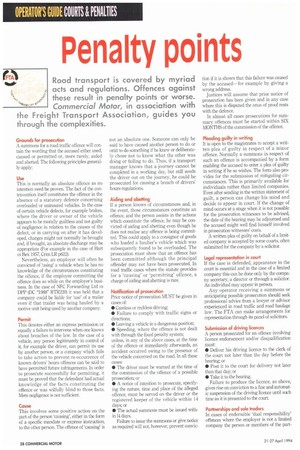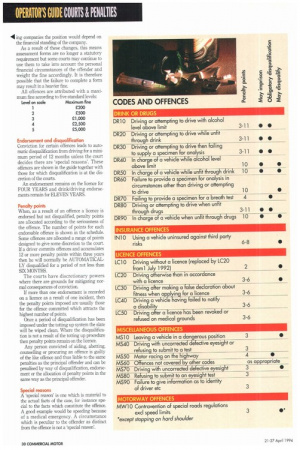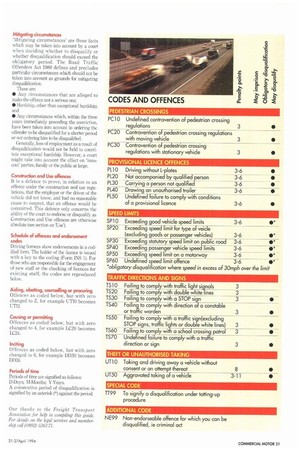Penalty points
Page 32

Page 33

Page 34

Page 35

If you've noticed an error in this article please click here to report it so we can fix it.
rN Road transport is covered by myriad
■ 10 acts and regulations. Offences against
". these result in penalty points or worse.
the Freight Transport Association, guides you through the complexities.
Grounds for prosecution
A summons for a road traffic offence will contain the wording that the accused either used, caused or permitted or, more rarely, aided and abetted. The following principles generally apply:
Use This is normally an absolute offence as no intention need be proven_ The fact of the contravention itself constitutes the offence in the absence of a statutory defence concerning overloaded or uninsured vehicles. In the case of certain vehicle defects, for example brakes, where the driver or owner of the vehicle appears to be morally guiltless and not guilty of negligence in relation to the causes of the defect, or in carrying on after it has developed, charges might not normally be brought and, if brought, an absolute discharge may be appropriate (For example in the case of Hart vs Bex 1957, Crim LR p622).
Nevertheless, an employer will often be convicted of 'using' a vehicle when he has no knowledge of the circumstances constituting the offence, if the employee committing the offence does so while on the employer's business. In the case of NFC Forwarding Ltd vs DPP (DC "1988" RTR239) it was held that a company could be liable for 'use' of a trailer even if that trailer was being hauled by a motive unit being used by another company.
Permit This denotes either an express permission or equally a failure to intervene when one knows about breaches of the law. In the case of a vehicle, any person legitimately in control of it, for example the driver, can permit its use by another person, or a company which fails to take action to prevent re-occurrence of known drivers' hours offences can be said to have permitted future infringements. In order to prosecute successfully for permitting, it must be proved that the defendant had actual knowledge of the facts constituting the offence or was wilfully blind to those facts. Mere negligence is not sufficient.
Cause This involves some positive action on the part of the person 'causing', either in the form of a specific mandate or express instruction, to the other person. The offence of 'causing' is not an absolute one. Someone can only be said to have caused another person to do or omit to do something if he knew or deliberately chose not to know what the other was doing or failing to do. Thus, if a transport manager knows that a journey cannot be completed in a working day, but still sends the driver out on the journey, he could be prosecuted for causing a breach of drivers' hours regulations.
Aiding and abetting If a person knows of circumstances and, in the event, those circumstances constitute an offence, and the person assists in the actions which constitute the offence, he may be convicted of aiding and abetting even though he does not realise any offence is being committed. This could apply to a consignor of goods who loaded a haulier's vehicle which was subsequently found to be overloaded. The prosecution must show that an offence has been committed although the principal offender may not have been prosecuted. In road traffic cases where the statute provides for a `causing' or 'permitting' offence, a charge of aiding and abetting is rare.
Notification of prosecution Prior notice of prosecution MUST be given in cases of: • Careless or reckless driving; • Failure to comply with traffic signs or directions; • Leaving a vehicle in a dangerous position; • Speeding, where the offence is not dealt with through the fixed penalty system; unless, in any of the above cases, at the time of the offence or immediately afterwards, an accident occurred owing to the presence of the vehicle concerned on the road. In all these cases: • The driver must be warned at the time of the commission of the offence of a possible prosecution; or • A notice of intention to prosecute, specifying the nature, time and place of the alleged offence, must be served on the driver or the registered keeper of the vehicle within 14 days; or • The actual summons must be issued within 14 days.
Failure to issue the summons or give notice as required will not, however, prevent convic
tion if it is shown that this failure was caused by the accused—for example by giving a wrong address.
Justices will assume that prior notice of prosecution has been given and in any case where this is disputed the onus of proof rests with the defence.
In almost all cases prosecutions for summary offences must be started within SIX MONTHS of the commission of the offence.
Pleading guilty in writing It is open to the magistrates to accept a written plea of guilty in respect of a minor offence. Normally a summons in respect of such an offence is accompanied by a form enabling the accused to enter a plea of guilty in writing if he so wishes. The form also provides for the submission of mitigating circumstances. This is primarily available for individuals rather than limited companies. Even after sending in the written statement of guilt, a person can change his mind and decide to appear in court. If the change of mind occurs at a stage when it is not possible for the prosecution witnesses to be advised, the date of the hearing may be adjourned and the accused might well find himself involved in prosecution witnesses' costs.
A written plea of guilty on behalf of a limited company is accepted by some courts, often submitted for the company by a solicitor.
Legal representation in court If the case is defended, appearance in the court is essential and in the case of a limited company this can be done only by the company secretary, a director or through a solicitor. An individual may appear in person.
Any operator receiving a summons or anticipating possible prosecution should seek professional advice from a lawyer or advisor experienced in road traffic and road haulage law. The FTA can make arrangements for representation through its panel of solicitors.
Submission of driving licences A person prosecuted for an offence involving licence endorsement and/or disqualification must • Deliver his driving licence to the clerk of the court not later than the day before the hearing; or • Post it to the court for delivery not later than that day; or • Take it to the hearing.
Failure to produce the licence, as above, gives rise on conviction to a fine and automatic suspension of the driving licence until such time as it is presented to the court.
Partnerships and sole traders In cases of endorsable 'dual responsibility' offences where the employer is not a limited company the person or members of the part nership employing the driver are also liable to have their licences endorsed.
Dangerous driving
Amongst the provisions introduced by the Road Traffic Act 1991 is the concept of 'dangerous driving'. This, unlike 'reckless driving' is to be assessed against the objective test of 'did the driving fall far below what would be expected of a competent and careful driver and would it be obvious to a competent and careful driver that driving in that way would be dangerous'. 'Dangerous' includes danger either of injury to any person or of serious damage to property. It can also include the state of the vehicle and load. If found guilty of dangerous driving 12 months disqualification is mandatory and the court can also require an appropriate; ie extended, driving test to be taken before the licence is restored.
Using a vehicle in a dangerous condition
The Road Traffic Act 1991 creates three new primary offences where prosecution would previously have been under the construction and use regulations. These are: • Using a vehicle in a dangerous condition; • Breach of requirement as to brakes, steering gear or tyres; • Breach of requirement as to weight.
The court will be able to endorse a licence with three points and can have discretion as to disqualification subject to being satisfied that there are no 'special reasons', ie the driver did not know nor had reasonable cause to suspect that the use of the vehicle involved danger of injury to any person. It is anticipated that prosecutions under the act will be used only for the most serious cases.
Photographic evidence
Unsupported photographic evidence is now sufficient for prosecutions for both speeding and failure to comply with traffic signals. Defence of such prosecutions is expected to be extremely difficult.
Standard scales of fines
The unit fine system was replaced in September 1993 by provisions requiring courts to take account of an offender's financial circumstances. New magistrates' guidelines were issued in September 1993 as a consequence. The new guidelines offer a starting point based on an "average offence" without aggravating factors and a not guilty plea. A discount of up to one third may be given for a "prompt guilty plea".
The guidelines emphasise the seriousness accorded to drink/driving offences. Those offenci.s for which variable penalty points can be awarded will have the seriousness of the offences taken into account at endorsement and the fine will be adjusted to the financial circumstances of the offender. Where an offender is convicted of a large number of offences the guidelines suggest that the court take an overall view and decide on the maximum total amount of the fines which would be appropriate, "even though this total may prove to be considerably less than the figure which would result from adding together all the suggested penalties involved". When fin
.11 ing companies the position would depend on the financial standing of the company.
As a result of these changes, this means assessment forms are no longer a statutory requirement but some courts may continue to use them to take into account the personal financial circumstances of the offender and weight the fine accordingly. It is therefore possible that the failure to complete a form may result in a heavier fine.
All offences are attributed with a maximum fine according to five standard levels:
Endorsement and disqualification
Conviction for certain offences leads to automatic disqualification from driving for a minimum period of 12 months unless the court decides there are 'special reasons'. These offences are shown in the guide together with those for which disqualification is at the discretion of the courts.
An endorsement remains on the licence for FOUR YEARS and drink/driving endorsements remain for ELEVEN YEARS.
Penalty points
When, as a result of an offence a licence is endorsed but not disqualified, penalty points are allocated according to the seriousness of the offence. The number of points for each endorsable offence is shown in the schedule. Some offences are allocated a range of points designed to give some discretion to the court. If a driver commits offences and accumulates 12 or more penalty points within three years then he will normally be AUTOMATICALLY disqualified for a period of not less than SIX MONTHS.
The courts have discretionary powers where there are grounds for mitigating normal consequences of conviction, If more than one endorsement is recorded on a licence as a result of one incident, then the penalty points imposed are usually those for the offence committed which attracts the highest number of points.
Once a period of disqualification has been imposed under the totting up system the slate will be wiped clean. Where the disqualification is not a result of the totting up procedure then penalty points remain on the licence.
Any person convicted of aiding, abetting, counselling or procuring an offence is guilty of the like offence and thus liable to the same penalties as the principal offender and can be penalised by way of disqualification, endorsement or the allocation of penalty points in the same way as the principal offender.
Special reasons
A 'special reason' is one which is material to the actual facts of the case, for instance special to the facts which constitute the offence. A good example would be speeding because of a medical emergency. A circumstance which is peculiar to the offender as distinct from the offence is not a 'special reason'. Mitigating circumstances 'Mitigating circumstances' are those facts which may be taken into account by a court when deciding whether to disqualify or whether disqualification should exceed the obligatory period. The Road Traffic Offenders Act 1988 defines and precludes particular circumstances which should not be taken into account as grounds for mitigating disqualification.
These are: • Any circumstances that are alleged to make the offence not a serious one; • Hardship, other than exceptional hardship; and • Any circumstances which, within the three years immediately preceding the conviction, have been taken into account in ordering the offender to be disqualified for a shorter period or not ordering him to be disqualified.
Generally, loss of employment as a result of disqualification would not be held to constitute exceptional hardship. However, a court might take into account the effect on 'innocent' parties, family or the public at large.
Construction and Use offences It is a defence to prove, in relation to an offence under the construction and use regulations, that the employer or the driver of the vehicle did not know, and had no reasonable cause to suspect, that an offence would be committed. This defence only concerns the ability of the court to endorse or disqualify as Construction and Use offences are otherwise absolute (see section on Use).
Schedule of offences and endorsement codes Driving licences show endorsements in a codified form. The holder of the licence is issued with a key to the coding (Form INS I). For those who are responsible for the engagement of new staff or the checking of licences for existing staff, the codes are reproduced below.
Aiding, abetting, counselling or procuring Offences as coded below, but with zero changed to Z, for example 1JT10 becomes UT12.
Causing or permitting
Offences as coded below, but with zero changed to 4, for example LC20 becomes LC24.
Inciting Offences as coded below, but with zero changed to 6, for example DD30 becomes DD36.
Periods of time
Periods of time are signified as follows: D-Days; M-Months; Y-Years.
A consecutive period of disqualification is signified by an asterisk (*) against the period.
Our thanks to the Freight Transport Association for help in compiling this guide. For Mails on the legal senices and membership call (0892) 526171.
























































































